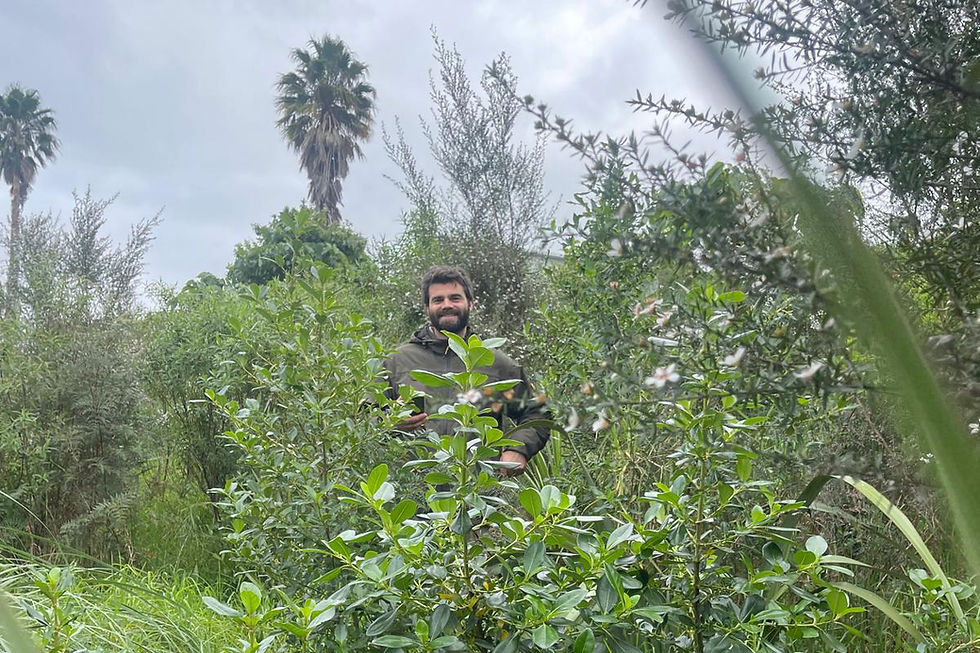Signs of belonging
- Te Hōnonga a Iwi

- Aug 21
- 3 min read

Student journalist Fareh Farhan takes a close up look at an art project to increase engagement with our restoration's green spaces and community areas.
Te Hōnonga a Iwi has always been a place of transformation for the land, the water and the people. In its latest effort to deepen connection between the community and the natural space, the project has unveiled a series of hand-painted creative signs along the restoration site. But these aren't just direction markers or basic information boards. These are expressions of belonging, identity and environmental storytelling.
The vision
The idea for the signage first sprouted during community kōrero, where team members reflected on ways to increase engagement with the space. The goal was simple yet powerful: create a landscape that not only heals the whenua but also welcomes and educates those who walk it. Inspired by values such as social equity, environmental health, organisational resilience and belonging, the signs were designed to repurpose waste while planting seeds of meaning.
Real estate signage headed for landfill became the canvas. Durable, weather-resistant and widely available through the local recycle centre and real estate offices, these materials embodied the kaupapa of repurposing and reducing waste. Their long lifecycle made them ideal for outdoor use, while their symbolic transformation paralleled the environmental restoration taking place at Rosedale Park.

The creative process
The artistic process was a true collaboration. Samantha Weston, Te Hōnonga a Iwi’s graphic designer, created the bold and colourful signage designs, drawing on the project’s established branding. Rainbow hues were chosen to symbolise diversity and inclusion which are the values at the heart of the kaupapa. Rangitoto College students brought these designs to life through careful painting, while Kristin School students will add the finishing touches, placing logos and text to indicate each sign’s purpose.
Each sign was kept visually simple and bold, with blocky shapes and crisp lettering to ensure visibility from afar. This simplicity wasn’t a limitation, it was a strategic decision. Students could easily replicate designs, problem-solve with limited materials, and learn by doing. In fact, the entire experience was one of trial and error, with students using initiative to decide word placement, fix mistakes and adapt tools such as transfer tapes for lettering.

"We didn't just give them instructions," Samantha says. "We gave them the space to create, to take risks, and to collaborate in a low-pressure, supportive environment."
Youth leadership action
The collaboration between student leaders in the sign-making process fostered more than just beautiful signs. It created friendships, sparked career conversations and opened space for creative exploration. Some students who struggled with confidence or mental wellbeing found a new sense of purpose in and through the project.
This is what sets Te Hōnonga a Iwi apart. Youth aren’t just invited to plant trees or clean up streams. They're empowered to shape the narrative. Through art, design and expression, young people have brought the kaupapa to life in ways that resonate with their generation. This is not only meaningful for today but essential for tomorrow.
Looking ahead
Phase two of the signage project is now underway: adding text to the images. These messages speak to everything from carbon sinks and pollinator zones, to peace-making and cultural stories. A new bee sign is also being introduced to celebrate the addition of two hives to the site, another step forward in biodiversity restoration.
Plans are already in motion to expand creative storytelling across the stream and into new spaces. With funding from Auckland Council and Mountains to Sea, the project hopes to integrate more youth-led art, music and performance into the restoration journey.
"We're thinking 100 years ahead," says Project Co-ordinator Nicky Shave. "The restoration isn’t just physical. It's cultural, emotional and intergenerational."
Future events may include musical signage, spoken word performances, exhibitions and even interactive art trails. The creative vision is as wide as the community's imagination.

Get involved
Young creatives across Tāmaki Makaurau are encouraged to get involved. Whether you’re a musician, painter, journalist or dreamer, there’s space for your voice in Te Hōnonga a Iwi. Restoration, after all, is not just about planting. It's about expression. Connection. Belonging.
This is restoration with colour. With laughter. With heart.
And these signs? They're not just wayfinders. They're the beginning of something much bigger.

















Comments